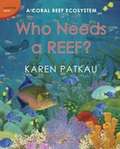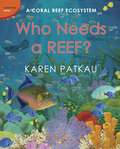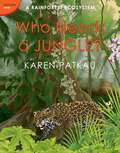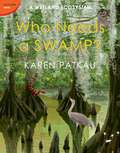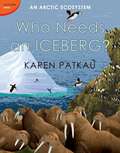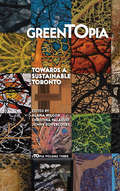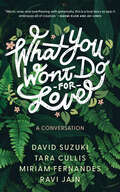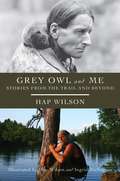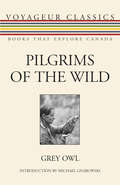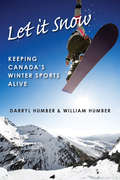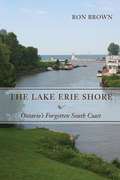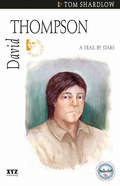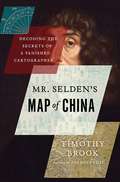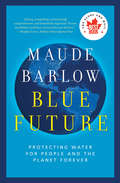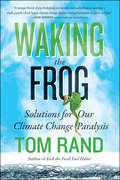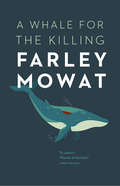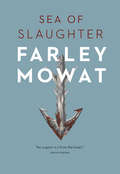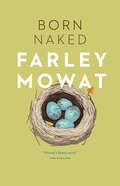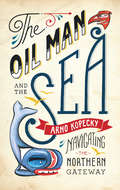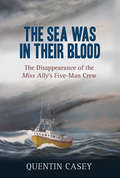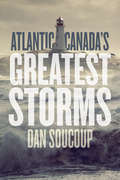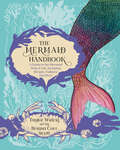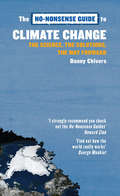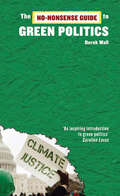- Table View
- List View
Who Needs A Reef?: A Coral Reef Ecosystem (Ecosystem)
by Karen PatkauWho Needs a Reef A Coral Ecosystem
Who Needs a Reef?: A Coral Reef Ecosystem (Ecosystem Series)
by Karen PatkauKaren Patkau takes readers on an amazing voyage of discovery to find out • How coral reefs form • Why coral reefs bustle and teem with life • Why there are more kinds of living things on coral reefs than anywhere else in the sea • What the types of hard corals are • Which plants and animals attach themselves to coral reefs • How coral reefs protect shorelines • How coral reefs help develop natural harbors and beaches • Where the coral reef areas of the world are • Why we need coral reefs
Who Needs a Jungle? (Ecosystem Series)
by Karen PatkauTundra introduces the first three books in its important new ecosystems series. Each title celebrates the world&’s diversity by presenting a different ecosystem: its land and water, its animals and plants. The art is brimming with creatures and ecological features, described in fact-filled notes at the end of each book and in a useful glossary and map. Jungles are treasures for all of us, regardless of where we live. In Who Needs a Jungle? we learn about its vital role in providing us with oxygen, food, medicinal ingredients, and raw materials we use every day. Not only is each book informative and beautiful, but it is a call to action for everybody who cares about the world in which we live.
Who Needs a Swamp? (Ecosystem Series)
by Karen PatkauTundra introduces the first three books in its important new ecosystems series. Each title celebrates the world&’s diversity by presenting a different ecosystem: its land and water, its animals and plants. The art is brimming with creatures and ecological features, described in fact-filled notes at the end of each book and in a useful glossary and map. Swamps are often seen as a dangerous and useless. They are often drained to create farmland or to reduce diseases. But such measures can be disastrous. Who Needs a Swamp? explores wetlands and their importance in the food chain and in preserving our soil and clean water. Not only is each book informative and beautiful, but it is a call to action for everybody who cares about the world in which we live.
Who Needs an Iceberg? (Ecosystem Series)
by Karen PatkauTundra introduces the first three books in its important new ecosystems series. Each title celebrates the world&’s diversity by presenting a different ecosystem: its land and water, its animals and plants. The art is brimming with creatures and ecological features, described in fact-filled notes at the end of each book and in a useful glossary and map. Who Needs an Iceberg? The Arctic ecosystem is changing rapidly. The Arctic Ice Cap is melting, the habitat for the creatures that live in the north is shrinking, and the earth is warming up. The impact is enormous for all of us.Not only is each book informative and beautiful, but it is a call to action for everybody who cares about the world in which we live.
Greentopia: Towards a Sustainable Toronto (uTOpia)
by Jonny Dovercourt Alana WilcoxGardening the Gardiner. Hydrogen-fuelled cabs. Rooftop Power. Rainwater harvesting. A new model of taxation. The art of salvage. Drinking less coffee. Composters for dog poo in city parks. Ravine City.What would make Toronto a greener place?This third book in the uTOpia series asked imaginative Torontonians to think both big and small about how we might make our city more environmentally wise and responsible. They responded with immodest proposals and how-to tips, thoughtful considerations and flights of fancy that just might work. They wrote essays long and short, taking stock of how far weve come in the struggle to green ourselves and providing suggestions for simple actions with big effects. Their ideas sometimes playful, sometimes pie-in-the-sky offer brazen new perspectives on transportation, garbage, trees, energy, water, animals and green space and arrive at imaginative and ingenious solutions to the problems plaguing all modern cities.GreenTOpia features a resources section, including profiles of key eco-friendly groups in the GTA, a directory of green organizations, as well as a how-to guide and a fun-facts section.
What You Won’t Do For Love: A Conversation
by David Suzuki Tara Cullis Miriam Fernandes Ravi JainWhat if we could love the planet as much as we love one another? "Warm, wise, and overflowing with generosity, this is a love story so epic it embraces all of creation. Yet another reminder of how blessed we are to be in the struggle with elders like David and Tara.” – Naomi Klein and Avi Lewis What You Won’t Do for Love is an inspiring conversation about love and the environment. When artist Miriam Fernandes approaches the legendary eco-pioneer David Suzuki to create a theatre piece about climate change, she expects to write about David’s perspective as a scientist. Instead, she discovers the boundless vision and efforts of Tara Cullis, a literature scholar, climate organizer, and David’s life partner. Miriam realizes that David and Tara’s decades-long love for each other, and for family and friends, has only clarified and strengthened their resolve to fight for the planet. What You Won’t Do for Love transforms real-life conversations between David, Tara, Miriam, and her husband Sturla into a charmingly novel and poetic work. Over one idyllic day in British Columbia, Miriam and Sturla take in a lifetime of David and Tara’s adventures, inspiration, and love, and in turn reflect on their own relationships to each other and the planet. Revealing David Suzuki and Tara Cullis in an affable, conversational, and often comedic light, What You Won’t Do For Love asks if we can love our planet the same way we love one another.
Grey Owl and Me: Stories From the Trail and Beyond
by Hap Wilson Ingrid ZschognerHap Wilson is back for another journey, this time on the lighter side of the adventure trail, where the bizarre melds with the sublime. Nurtured by the writings of Canadian environmentalist and wannabe-Native, Grey Owl, Wilson adopted a lifestyle similar to the 1930s conservationist but with his own twists and turns along a meandering path full of humorous misadventures. Wilson, too, learned many of his nature skills as a youth, paddling in Temagami, working as a wilderness canoe ranger and guide, and following in the footsteps of one of Canada’s most revered outdoor icons. The author recounts early days winter camping, motorcycling the Labrador coast, and teaching actor Pierce Brosnan how to throw knives and paddle a canoe for the Richard Attenborough film about Grey Owl. He also takes us to a few of his favourite places and shares intimate secrets of wilderness living. Here, Grey Owl has returned as an ever-present critic – a buckskin-clad spectre in a modern world of Gore-Tex, Kevlar canoes, and gear freaks.
Pilgrims of the Wild
by Grey Owl Michael Gnarowski Hugh EayrsFirst published in 1935, Pilgrims of the Wild is Grey Owl’s autobiographical account of his transition from successful trapper to preservationist. With his Iroquois wife, Anahereo, Grey Owl set out to protect the environment and the endangered beaver. Powerful in its simplicity, Pilgrims of the Wild tells the story of Grey Owl’s life of happy cohabitation with the wild creatures of nature and the healing powers of what he referred to as "the great Northland" of "Over the Hills and Far Away." A bestseller at the time, Pilgrims of the Wild helped establish Grey Owl’s international reputation as a conservationist. His legacy of warnings against the degradations of nature and the dangers of industry live on, despite the posthumous revelation that he wasn’t, in fact, the First Nations man he claimed to be.
Let It Snow: Keeping Canada's Winter Sports Alive
by Darryl Humber William HumberWinter has shaped Canada’s image and has been embraced with hearty enthusiasm from snowshoeing hikers in the nineteenth century, to future hockey stars on backyard rinks, to the indoor spectacle of figure-skating carnivals and curling bonspiels. Much of our literature, our songs, and our memories of youth reflect the bracing tonic that winter brings even as we curse the ice-laden roads on morning commutes or during weekend ski trips. But alas, winter’s demise to a weak reminder of its former glory is a real possibility as climate change wreaks long-term havoc. This timely book takes a fond look at winter’s past, its place in Canada’s story, and how it has shaped our sports history. It also explores what climate change means for our sense of Canadian identity, for our winter sports heritage and its related industries, and for our ability to hold winter sporting events beyond the 2010 Winter Olympics in Vancouver.
The Lake Erie Shore: Ontario's Forgotten South Coast
by Ron BrownThe Lake Erie shoreline has born witness to some of Ontario’s earliest history, yet remains largely unspoiled. Much of the area’s natural features - the wetlands, the Carolinian forests - and its built heritage - fishing ports and military ramparts - provide much of interest for vistors to the region. Ron Brown has traversed this most southern coast line in Ontario, fleshing out forgotten stories of the past, from accounts of the world’s largest freshwater fishing fleet, War of 1812 skirmishes, links with the Underground Railroad, forgotten outposts and canals, the introduction of wineries, and the legacy of the many appealing towns and villages that hug the shoreline.
David Thompson
by Tom ShardlowAcross North America in 2007-2009, communities will celebrate the David Thompson Bicentennials. For 34 years the great explorer, surveyor, and fur trader travelled across the continent, finding and mapping the routes between the St. Lawrence and the Pacific. Trusting the stars and his sextant, he surveyed a continental area so vast it remains a mapping achievement unequalled in human history. This is the story of David Thompsons epic journey his trail by stars.
Mr. Selden's Map of China: Decoding the Secrets of a Vanished Cartographer
by Timothy BrookSelected for The Globe 100 Books in 2013. A fascinating work of history, biography, cartography, and literary mystery, Mr Selden’s Map of China unlocks the secrets behind a recently discovered map of China like no other of its time. In 1659, a vast and unusual map of China arrived in the Bodleian Library, Oxford. It was bequeathed by John Selden, a London business lawyer, political activist, former convict, MP, and the city’s first Orientalist scholar. Largely ignored, it remained in the bowels of the library, until called up by an inquisitive reader. When Timothy Brook saw it in 2009, he realized that the Selden Map was “a puzzle that had to be solved”: an exceptional artefact so unsettlingly modern-looking it could almost be a forgery. But it was genuine, and what it has to tell us is astonishing. It shows China, not cut off from the world, but a participant in the embryonic networks of global trade that fuelled the rise of Europe — and now power China’s ascent. And it raises as many question as it answers: How did John Selden acquire it? Where did it come from? Who re-imagined the world in this way and, most importantly, what can it tell us about the world at that time? Like a cartographic detective, award-winning author and historian Timothy Brook has provided answers. From the Gobi Desert to the Philippines, from Java to Tibet, and into China itself, Brook uses the map to tease out the varied elements that defined this crucial period in China’s history.
Blue Future: Protecting Water for People and the Planet Forever
by Maude BarlowSelected for The Globe 100 Books in 2013. The final book in Maude Barlow’s Blue trilogy, Blue Future is a powerful, penetrating, and timely look at the global water crisis — and what we can do to prevent it. The global water crisis has dramatically deepened. The stage is being set for drought on an unprecedented scale, mass starvation, and the migration of millions of refugees leaving parched lands in search of water. The story does not need to end in tragedy. In Blue Future, international bestselling author Maude Barlow offers solutions to the global water crisis based on four simple principles. Principle One: Water Is a Human Right chronicles the long fight to have the human right to water recognized and the powerful players still impeding this progress. Principle Two: Water Is a Common Heritage and Public Trust argues that water must not become a commodity to be bought and sold on the open market. Principle Three: Water Has Rights Too makes the case for the protection of source water and the need to make our human laws compatible with those of nature. Principle Four: Water Will Teach Us How to Live Together urges us to come together around a common threat — the end of water — and find a way to live more lightly on this planet. The final instalment in Barlow’s Blue trilogy, Blue Future includes inspiring stories of struggle and resistance from marginalized communities, as well as examples of government policies that work for people and the planet. A call to action to create a water-secure world, it is, in the end, a book of hope.
Waking the Frog: Solutions for Our Climate Change Paralysis
by Tom Rand<p>A venture capitalist, entrepreneur, and engineer, Tom Rand looks to contemporary psychology, economics, business, and finance to explain our difficulty in confronting one of the most fundamental problems of our time. Rand’s account doesn’t just point fingers at the bad guys, but goes deeper—to our motivations, institutional lethargy, and deeply buried assumptions about market economics. <p>Waking the Frog reveals that our ingenuity, technology, capital, and policy can work together to turn down the heat—and at the same time enable the largest economic opportunity of the twenty-first century. </p>
A Whale for the Killing
by Farley MowatWhen an 80-ton Fin Whale became trapped in a lagoon near his Newfoundland home, Farley Mowat rejoiced: here was a unique chance to observe one of the world's most magnificent creatures up close. But some of his neighbours saw a different opportunity altogether: in a prolonged fit of violence, they blasted the whale with rifle fire, and scarred its back with motorboat propellers. Mowat appealed desperately to the police, to marine biologists, finally to the Canadian press. But it was too late. Mowat's poignant and compelling story is an eloquent argument for the end of the whale hunt, and the rediscovery of the empathy that makes us human.
Sea of Slaughter
by Farley MowatThe northeastern seaboard of North America, extending from Labrador to Cape Cod, was the first region of North America to suffer from human exploitation. <P><P>Farley Mowat informs the extensive historical and biological research with his direct experience living in and observing this region. When it was first published nearly thirty years ago, Sea of Slaughter served as a catalyst for environment reform, raising awareness of the decline and destruction of marine and coastal species. Today, it remains a prescient and chilling environmental classic, serving, now as ever, as a haunting reminder of the impact of human interest on the natural world.
Born Naked
by Farley MowatFarley Mowat's outrageous memoir begins with his unlikely conception in a canoe and continues to his boyhood fascination with creatures of the natural world and on to his youthful rambles and adventures. To his immense pleasure and his parents' dismay, he adopted various beasts (whom he affectionately calls "The Others") as roomates. In this boyhood memoir, he recounts the exploits of this second family, who have been the subjects of many of his beloved books for young readers. This is the tale of a mischievous, immensely gifted young naturalist, recounted with the wisdom, humour and grown-up perspective of a very talented writer.
Born Naked
by Farley MowatFarley Mowat's outrageous memoir begins with his unlikely conception in a canoe and continues to his boyhood fascination with creatures of the natural world and on to his youthful rambles and adventures. To his immense pleasure and his parents' dismay, he adopted various beasts (whom he affectionately calls "The Others") as roomates. In this boyhood memoir, he recounts the exploits of this second family, who have been the subjects of many of his beloved books for young readers. This is the tale of a mischievous, immensely gifted young naturalist, recounted with the wisdom, humour and grown-up perspective of a very talented writer.
The Oil Man and the Sea: Navigating the Northern Gateway
by Arno KopeckyA sailing trip along the proposed Northern Gateway marine route with a fresh new voice in non-fiction.With oil and gas behemoth Enbridge Inc.'s Northern Gateway proposal nearing approval, supertankers loaded with two million barrels of oil may soon be plying the waters from northern British Columbia down the wild Pacific Coast. <P><P>This region is home to the largest tract of temperate rainforest on earth, First Nations who have lived there for millennia, and some of the world's most biodiverse waters-one spill is all it will take to erase ten thousand years of evolution.Arno Kopecky and his companions travel aboard a forty-one-foot sailboat exploring the pristine route-a profoundly volatile marine environment that registered 1,275 marine vessel incidents-mechanical failures, collisions, explosions, groundings, and sinkings-between 1999 and 2009 alone. Neither Kopecky nor the boat's owner have ever sailed before, yet they brave these waters alone when their captain leaves them part way through the journey.Written with Kopecky's quick humor and deft touch, this is a rich evocation of a mythic place and the ecology, culture, and history of a legendary region with a knife at its throat.
The Sea Was in Their Blood: The Disappearance of the Miss Ally's Five-Man Crew
by Quentin CaseyA journalist and maritime historian investigates the deadly 2013 storm that claimed the lives of five fishermen off the coast of eastern Canada. It was a frigid night in February 2013 when the five young fishermen vanished. The crew of the Miss Ally—a 12-metre Cape Islander from Woods Harbour, Nova Scotia—was fishing for halibut far off the Nova Scotia coast when their boat&’s spotlight malfunctioned. A vicious winter storm was approaching from her south, and all other boats at the fishing grounds were steaming for shore. Unable to locate his longlining gear, the Miss Ally&’s young captain decided to stay an extra day to retrieve the gear and, hopefully, a big catch. Their retreat delayed, the Miss Ally crew ended up pounded by hurricane-force winds and waves well over 10 meters high. Late on February 17, the boat foundered. The five young men aboard—Katlin Nickerson, Billy Jack Hatfield, Joel Hopkins, Cole Nickerson, and Tyson Townsend—were never found. The Sea Was in Their Blood explores two key questions: who were the men aboard the Miss Ally, and why were they battered and sunk by a storm forecasted days in advance? Through interviews with the crew&’s families and friends, rescue personnel, and members of the tight-knit fishing communities of Woods Harbour and Cape Sable Island, award-winning journalist Quentin Casey pieces together the tragic sinking—including important case details not previously reported—and weaves in the backstories of the Miss Ally&’s crew and the lingering effects of their disappearance. A portion of the royalties from the sale of this book will be donated to various charitable causes associated with the Miss Ally.
Atlantic Canada's Greatest Storms
by Dan SoucoupA fascinating exploration of the most dramatic storms along Canada&’s Atlantic coast, from 1745&’s Grand Armada Tragedy to the 2017 Ice Storm. Over the centuries, Canada&’s Atlantic coast has been battered by hurricanes and winter blizzards, struck by tornadoes, devastated by floods, and even hit by terrifying tsunamis. Now Dan Soucoup, a historian of Canada&’s Maritime Provinces, explores the region&’s most dramatic storms from the 18th century into the 21st in Atlantic Canada&’s Greatest Storms. Soucoup chronicles the North Atlantic&’s greatest hurricanes, including the 1775 Independence Hurricane, the Saxby Gale in 1869, and Hurricane Igor in 2010. He also recounts a terrifying series of blizzards in 1905, The Year of the Deep Snow, which left passenger trains stranded for days in the Annapolis Valley; as well as Newfoundland&’s 1929 tsunami, which devastated the Burin Peninsula, striking dozens of coastal communities and carrying people and homes out to sea. Features 25 black and white images.
The Mermaid Handbook: A Guide to the Mermaid Way of Life, Including Recipes, Folklore, and More
by Taylor Widrig Briana Corr Scott&“Contains profiles of mermaids from around the world complete with folklore about each maiden . . . a must-have if you are fascinated with mermaids.&” —BeachcombingThe book mermaids-in-training have been waiting for. From history and folklore to recipes and tips for ocean preservation, as well as profiles and original illustrations of mer-maidens from around the world, The Mermaids Handbook features everything you need to know to follow the mermaid way of life.]Over 40 healthy and accessible recipes, developed by author Taylor Widrig of Mermaid Fare, a Nova Scotia–based company specializing in wild and cultivated sea vegetables, include scrumptious starters like Mermaid Kaiso Seaweed Salad, new classics like Dulse, Lettuce, and Tomato Sandwich and Creamy Wakame Casserole, as well as healthy snacks like Smoothie Bowls and Energy Bites, and even homemade beauty products, such as the Coconut Sea Hair Mask—for that salty sea-hair.Includes an introduction by Dr. Alan Critchley with everything you&’ve ever wanted to know about seaweeds and original 2-colour illustrations by artist Briana Corr Scott (The Book of Selkie).&“Nova Scotia sea-vegetable advocate Taylor Widrig is hoping to lure a new generation into the depths with her debut book . . . Written in a conversational tone, Widrig&’s scientific explanations are fascinating and age appropriate.&” —Quill & Quire
No-Nonsense Guide to Climate Change: The Science, the Solutions, the Way Forward (No-Nonsense Guides #3)
by Danny ChiversJust as the need for action on climate change becomes more urgent and overwhelming, the campaign to deny that humans are causing it has gained more traction. This completely new book meets the skeptics head on, offering a guide to the science, an insight into the politics of climate justice and a clear sense of the way forward. This is an ideal offering for students, academics and anyone interested in the growing issue of society’s impact on climate change and how to make climate justice a reality.
No-Nonsense Guide to Green Politics (No-Nonsense Guides #13)
by Derek WallClimate chaos and pollution, deforestation and consumerism: the crisis facing human civilization is clear enough. But the response of politicians has been cowardly and inadequate, while environmental activists have tended to favour single-issue campaigns rather than electoral politics. The No-Nonsense Guide to Green Politics measures the rising tide of eco-activism and awareness and explains why this event heralds a new political era worldwide: in the near futurethere will be no other politics but green politics.
